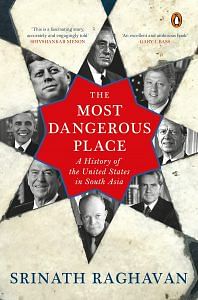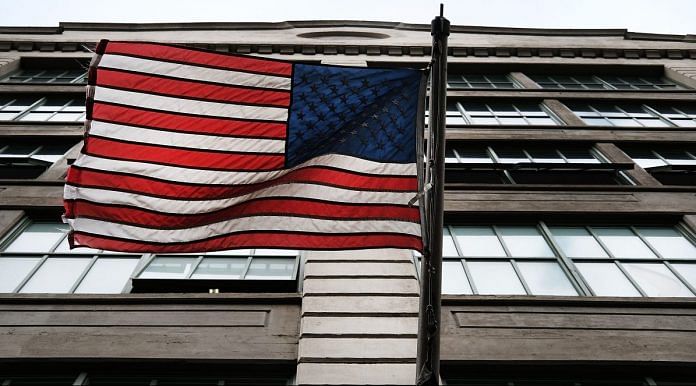Srinath Raghavan’s broad and detailed swathe of the US-South Asia relationship beautifully brings out the inherent contradiction in the heart of US policy.
As US President Donald Trump threatens to upend, overhaul or repair several considered decisions by previous administrations, including on South Asia, it is worth remembering that the actions and reactions by today’s policymakers in Delhi, Islamabad and Kabul are embedded in a 200-year-old engagement with the US in which both enthusiasm and apathy have ebbed and flowed, admittedly in unequal measure.
Srinath Raghavan’s The Most Dangerous Place takes its title from a comment by former US president Bill Clinton, on the eve of his India visit in 2000, two years after the US imposed sanctions on India and Pakistan for their tit-for-tat nuclear tests. A year later, both neighbours had been locked into an eyeball-for-eyeball conflict in the mountains of Kashmir, while the world held its breath dreading the escalation into nuclear war.
Bill Clinton forced Nawaz Sharif to walk the Pakistan army back across the Line of Control in 1999, setting off a chain of events that resulted in a coup against Sharif — he was thrown into Attock jail. But as Raghavan points out, US engagement with South Asia (the story is focussed on India, Pakistan and Afghanistan) actually began more than 200 years ago, when the ‘United States’ sailed into Pondicherry in 1784, packed with tobacco and ginseng, copper and iron, “a considerable sum in dollars” and a hundred casks of Madeira wine.
There is the lovely story of Josiah Harlan, the adventurer who raised the US flag in Ludhiana in 1827 and momentarily became the chief of the Hazaras in Afghanistan – Rudyard Kipling’s The Man Who Would be King was supposedly inspired by this – and whose critical view of the British empire presaged the progressive strain in US policy a hundred years later, with Kennedy, Roosevelt, Clinton and Obama.
Of course, the early American view is shaped by British missionaries intent on civilizing the natives. But as the freedom struggle engulfs India and US missionaries are forced to respond, Duane Hatch sets up a rural cooperative in Martandam in erstwhile Travancore in the mid-1920s, believing that “self help with intimate counsel” is the only way out of poverty. The Ganga flows in the other direction too. In the US west coast around the same time, Lala Har Dayal quits Oxford to join a band of revolutionaries to start the Ghadar Party, whose primary aim is to liberate India from the Raj. By the time Gandhi embarks on his Dandi March in 1930 and tells the New York Times, that “…mere sympathy will avail me nothing. What is wanted is the concrete expression in favour of India’s inherent right to independence…” the American press is electrified.
In another age, much later, as the Chinese advance against Leh and Assam in 1962, prime minister Jawaharlal Nehru will write a “really desperate” letter to Kennedy. “We have to have more comprehensive assistance if the Chinese are to be prevented from taking over the whole of Eastern India,” he says, reiterating much the same message as Gandhi did during the freedom struggle.
But despite the fall of Singapore in 1942 and Roosevelt’s mounting sympathy for India’s sacrifices in the war (a million men would kill themselves in defence of the empire), the US president ultimately chickens out when confronting Churchill. “For the love of Heaven don’t bring me into this…It is strictly speaking none of my business,” FDR says, even as he proposes a temporary Dominion government for India “covering different castes, occupations, religions and geographies” as a response to the Indian nationalist struggle.
Raghavan’s broad and detailed swathe of the US-South Asia relationship beautifully brings out this inherent contradiction in the heart of US policy. On the one hand is the glorious push for ideas like liberty and equality and freedom, on the other is the necessary dive into the muck that must get your hands dirty – if only to protect the idea of America being a foremost power which also holds aloft the flag of democracy.
Some would call this hypocrisy. Ayub Khan of Pakistan certainly did in 1956 when he realised that the US would limit military aid to $171 million and economic aid to $105 million, in the afterglow of the US-Pakistani alliance. “I’ve stuck my neck out for the Americans. But I can’t go on doing it, because you’ve gone back on your word.” But Ayub’s grumbles hid a deeper truth: The US realised that the Pakistani dictator actually wanted it to kit out five and a half Pakistani divisions that would actually cost $301 million.
Were the Americans unwilling to call a spade a spade with Pakistan as early as the mid-1950s, just as they are today? Both Eisenhower and Nixon, and I daresay Clinton, Obama and Trump, have repeatedly reinvented the wheel on the US-Pakistan relationship, hectoring, wheedling, threatening and pussyfooting in alternating cycles as they realize their need for Rawalpindi is much higher than their irritation at its doublespeak. In the 1950s, Pakistan became a key US ally in the latter’s march towards a free world; in 1971, the “tilt” was a result of access provided to Kissinger desperate to open up to China; and in 1979, Pakistan became the entry point through which the battle against the godless Soviets who had just invaded Afghanistan would take place.
As for Afghanistan, one forgets that the country had a life before the 1979 invasion – Arnold Toynbee the historian, on a visit to Lashkar Gah in Helmand province in 1960, wrote that it was a “piece of America inserted into the Afghan landscape…” Today, it is the site of the worst Taliban attacks as well as burgeoning poppy production.
As India readjusts its “natural ally” promise Atal Bihari Vajpayee made to Clinton, and Modi reaches out to China and Russia in the age of Trump, one can’t help wondering if US-South Asia ties are condemned to a Sisyphean agony.
But Raghavan’s meticulously researched history also suffers from the fatal flaw of an eyeball-grabbing headline that deliciously reiterates the narrative of dread the West loves — nuclear weapons in an unstable Pakistan, the Taliban taking over Afghanistan etc – but doesn’t really reflect the reality on the ground. South Asia isn’t necessarily ‘the most dangerous place’ in the world, it’s a complex and fascinating tapestry that is never what it’s supposed to seem. So ignore the headline and go read the book. It’s an absorbing delight.
 Srinath Raghavan Penguin Random House 472 pages
Srinath Raghavan Penguin Random House 472 pages



